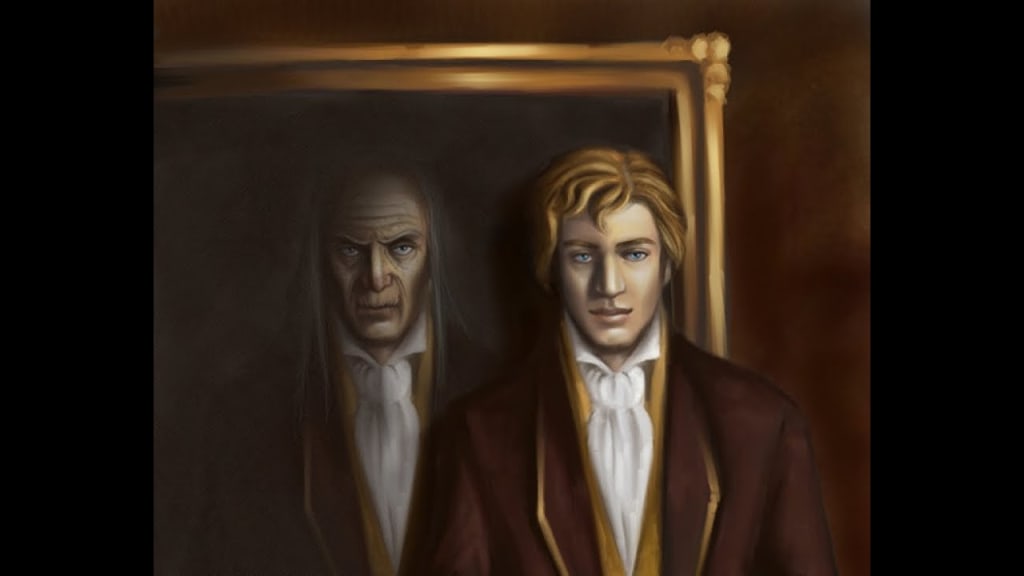"The Picture of Dorian Gray" and Immorality
An Essay

Published in the summer of 1890 in Lippincott’s Magazine, “The Picture of Dorian Gray” by Oscar Wilde has been closely associated with the era of decadence and hedonism during the fin-de-siecle because of its presentation of the fall of the upper class man. The character of Dorian is directly representative of the upper class youth who, by spending time with his elders and not contributing to society in any good way, has descended into a life of debauchery and sin. In the Victorian Era, the novel was seen as an absolute scandal because of its reflection of an upper class man, who in that time was seen as a model for society to follow - in the light of something that was closer to the nature of the peasantry (in the eyes of the upper class). This uproar caused the book to be banned and then edited, republished without many of the ‘sins’ that the public put it down to. Unfortunately, it caused the downfall of its author as well - landing him in a hard labour prison.

Victorian Literature is commonly known to have been written by the upper or middle classes and published as a means to model a good life. The British Library paper on aestheticism shows us that the very notion of aestheticism itself was immoral:
“Many Victorians passionately believed that literature and art fulfilled important ethical roles. Literature provided models of correct behaviour: it allowed people to identify with situations in which good actions were rewarded, or it provoked tender emotions.”
Thus, the ‘fulfilment of ethical roles’ was to deter writers away from publications such as “The Picture of Dorian Gray” since the supporters of this type of literature were deemed ‘immoral’ since it was the pursuit of perfection. This is ironic because the Victorian upper class has been, especially in our own time, so closely associated with decadence. The term ‘art for art’s sake’ though, is somewhat different to decadence. The pursuit of true beauty and the pursuit of perfection are two different things. “The Picture of Dorian Gray” has remained a stern example of it since later on in the book, the reader and Dorian are both unable to tell the difference between the two since Dorian himself is a key to what true beauty is but his soul is warped with decadence and thus, causes his downfall. The almost Shakespearean aspect to this shows us as readers that these two terms are not only not interchangeable, but they symbolise two entirely different idea when it comes to the main character and the very notion of him being ‘immoral’.

One of the most famed texts on the ideas of aestheticism was Walter Pater’s “Studies in the History of the Renaissance” in which Pater states that the only thing that an individual can have is the pursuit of lovely things and therefore, must engage in these pleasures. This would seem a great example to use alongside the quotation from Wilde’s “The Picture of Dorian Gray” - ‘the only way to get rid of temptation is to yield to it…’ Often thought to be a pursuit of the hedonistic and misinterpreted as the desire for self-indulgent pleasure, Pater was actually talking about ‘lovely things’ as ‘things that are beautiful’ such as he mentions Renaissance art and its celebration of the classical world. The thought of casting off the moral indoctrination of the Christian ideals within the Victorian Era for some of that time was absurd, to others it was progress. “The Picture of Dorian Gray” presents it as both. Something that is pleasurable to look at can be turned foul by the very misinterpretation that these people against aestheticism had. Thus the term ‘art for art’s sake’ is devoured by its own misunderstanding and we get a very Shakespearean tragedy full of fatal flaws and character studies.

In the first few chapters of “The Picture of Dorian Gray” we get a single meaning for the word ‘aestheticism’ and that is the appreciation of great beauty. It is directly represented by the way in which Basil speaks of his admiration for Dorian Gray to his friend, Lord Henry Wotton. Basil is somewhat middle class and Henry, a little higher on the social scale and thus, we can see that Basil is the purer form of aestheticism whereas, when Henry meets Dorian, this is more of a representation of how this aestheticism could be misinterpreted to mean something more in line with decadence. Since ‘decadence’ is defined as the over-luxurious and over-the-top self-indulgence which ultimately leads to the decay of society, we can see that the sort of hedonism suggested by Lord Henry Wotton is more in line with this and the appreciation that Basil has for Dorian is more tuned to aestheticism through the magnificent portrait of pure beauty that is presented.

It is this portrait that draws the line. The portrait itself is a mere representation of the pure beauty contained within Dorian at the time of their meeting. Though aestheticism does concentrate on perfection, “The Picture of Dorian Gray” interprets that perfection as the perfection of the soul. Therefore, when the picture is tainted by Dorian’s activities later on in the novel, it is the magnificent representation of pure beauty, also known as the soul, that is tainted and not the physical person that is being represented by the painting.
During the latter chapters of the novel, we see this transformation complete. Dorian stays in the image of true beauty whereas, the painting highlights what his soul is showing - the complete opposite of true and pure beauty. The question is whether Wilde is trying to show us that pure beauty can only be achieved by having both outer and inner appearances polished, or does it mean that as long as Dorian stays beautiful on the outside and presents true beauty, nobody in the upper class will be able to tell the difference. James Vane being the person who can and therefore, seeks out Dorian in order to murder him.

The reason for hiding this immoralism was also because of the practice of physiognomy in which appearance could often give away signs of moral indecency and so, whilst Dorian remained by face an aesthete’s dream of pure beauty - the painting was marked and scarred with all the acts of sin he had committed. The increase in immorality creates this breakage of the mind in which the protagonist can no longer recognise themselves after looking at the painting and he himself, only recognises the moral degeneracy which of course, would lead him to kill himself. The painting returns to its natural state of true beauty, bearing no marks or scars therefore suggesting that Dorian’s immoral soul has been removed from the painting and thus, there is nothing to mark it with sin. The ideas surrounding this include the fact that Dorian Gray was initially a man of pure beauty, copied into the portrait by Basil, who wished him to remain that way. The corruption by Henry therefore set this so called ‘curse’ into motion in which Dorian asks to remain the same whilst the painting change. And, unaware of how fatal that is, he comes to not recognising himself via image or soul, the disconnection ultimately kills him.
As a gothic text also, “The Picture of Dorian Gray” does an intricate job of representing the exploration of immoral acts undisclosed by members of the upper classes:
“Gothic imagery, given its fantastical nature, allowed authors to explore in an indirect fashion themes that were not necessarily acceptable subjects for discussion in respectable society.”
Cesare Lombroso would argue for this case as the upper classes were normally perfectly adorned and fashioned and yet, the criminal aspects of a person, according to his theories were that they could be seen in the face. This is a problem if anyone were to accuse Dorian Gray of being immoral to the point of criminal, which he actually is. Judging by Lombroso’s own theories, that would be near on impossible due to the way in which Dorian looks not only ‘perfect’ but also is adorned as an upper class man. It is actually something more suggestive that may give him away in the ‘scare’ nature of the Victorian gothic tradition. His appearance may be presumed perfect to an aesthete, but to the gothic inspector and critic, there is something that is ‘exotic’ about Dorian. His skin is an ‘olive’ colour. The gothic, especially in the Victorian age, ride with oriental depiction, was known for making a fright out of the ‘other’ and the ‘eastern’ whether that be Asian or further east in Europe. This mere suggestion could start the reader on their course to assuming Dorian was going to act out of character for his standing and therefore, make it slightly more understandable why he would be considered ‘immoral’ later on.
Dorian’s immorality is most obviously learnt and yet, we could argue that the nature of his soul or rather, his capacity for immoralism is much higher than average given the fact that his parents were considered to be outlaws to society for the nature of their marriage. It is Lord Henry Wotton though that is attributed with leading Dorian off the beaten path and into a life of hedonism and degeneracy. The way in which this matters becomes more and more apparent through the way in which Henry gifts not only advice to Dorian but also gifts him a certain book. A book thought to be the French Decadent novel “A Rebours” by JK Huysmans. After this, “The Picture of Dorian Gray” experiences some sort of ‘Volta’ or ‘turn of character’ in which Dorian becomes far more degenerate in seeing himself in the protagonist of this novel he holds. Henry’s wisdom and paradoxes, his speech and his arguments become more and more appealing to Dorian from the beginning but it is now the very notion that someone could know the real him that seems to grab his soul and make it become even more immoral since not only does he see himself in the main character, he seems to also want to be the main character at the same time. Experiencing this immoral state of character crisis, Dorian seeks to make his final transformation into the hedonistic monster that we know him as by the end of the novel.

In conclusion to this argument, the immorality of Dorian Gray is not just created by Lord Henry Wotton, but a number of factors that Oscar Wilde has dripped into the novel, making us revisit it like a curse that has a number of items waiting to be discovered. Each piece of this puzzle gets us one inch closer to learning who Dorian is and yet, we may not know the real him at all for it is his soul that is trapped in the painting. The question is not about just the immorality, but it is also to do with which Dorian we are learning about - the man or the representation of the man - and which way around they are.
Citation List:
https://www.bl.uk/romantics-and-victorians/articles/aestheticism-and-decadence
https://www.bl.uk/romantics-and-victorians/articles/gothic-fiction-in-the-victorian-fin-de-siecle
Wilde, O. (2012). The Picture of Dorian Gray. UK: Penguin English Library
About the Creator
Annie Kapur
200K+ Reads on Vocal.
English Lecturer
🎓Literature & Writing (B.A)
🎓Film & Writing (M.A)
🎓Secondary English Education (PgDipEd) (QTS)
📍Birmingham, UK







Comments
There are no comments for this story
Be the first to respond and start the conversation.